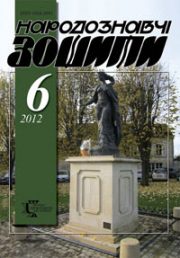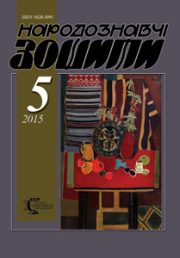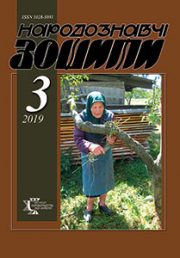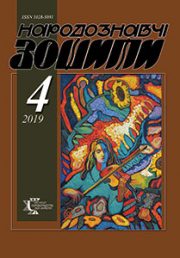The Ethnology Notebooks. 2022. № 2 (164), 377—384
UDK [398.8:783.65](477.84-21Бережани)”194/ 195″:329.1/.6
DOI https://doi.org/10.15407/nz2022.02.377
HOLUBETS Orysia
- ORCID ID: https://orcid.org/0000-0003-1568-900X
- Candidate of Philology,
- Research Fellow,
- Lviv Polytechnic National University,
- 12, Bandera St., 12, 79046, Lviv, Ukraine,
- Contacts: e-mail: holubetsor@ukr.net
Abstract. The proposed exploration analyzed carols of the 40—50s of the twentieth century from ten settlements of the Berezhany district of Ternopil region. The source base was own records of 2008—2009 and available printed materials. The relevance of the topic is due to the need of study the reflection of socio-political processes of the 40—50’s of the twentieth century, related to the national liberation competitions of Ukrainians, in oral poetic creativity, including ritual. The purpose of the work is to present, as in folklore, in particular in the calendar-ritual songs — carols, the reflected socio-political processes that took place during the specified period on Western Ukrainian lands in the conditions of Soviet totalitarianism.
The object of the study — texts of Christmas innovations from the Berezhany district of Ternopil region.
The subject is an artistic reflection in the texts of the Christmas social and political processes of the 40’s and 50’s of the twentieth century. Chronological boundaries of exploration — the middle of the XX century — the beginning of the XXI century.
The article was devoted to the development of research into the influence of socio-political processes of the 40—50’s of the twentieth century to change the paradigm of calendar-ritual songs of the winter cycle.
The mass Stalinist terror as a method of forming the state system aimed at the actual destruction of the conscious part of the Ukrainian population of Western Ukraine, annexed in 1939 to the USSR, and the suppression of the national liberation struggle. The insurgent carols that we looked at show very realistic pictures of the lives of most Ukrainians of that time (deportation to Siberia, prison inmates). As the only way out of the situation, the works represent the UPA’s armed struggle aimed at destroying the political order of the hostile invading state and creating a free cathedral of Ukraine with its capital in Kyiv.
Keywords: rebellious carols, ritual songs, Holy evening, political terror, repression, Siberia, Berezhany district, Ternopil region.
Received 16.05.2022
REFERENCES
- Holubets, O.M. (2010). Songs of Brzezany region. Collection. Archive of the IN NANU (Archive of the Institute of Ethnology of the National Academy of Sciences of Ukraine). F. 1. Op. 2. Od. save 627. Arc. 1—323 [in Ukrainian].
- Lavryshyn, Z. (Ed.). (1996—1997). Songs of the Ukrainian Insurgent Army. Chronicle of the Ukrainian Insurgent Army (Vol. 25). Toronto; Lviv: Litopys UPA [in Ukrainian].
- Kramar, R. (Ed.). (1995). Insurgent carols. The songs are collected in Western Podillya. Ternopil [in Ukrainian].
- Kharchyshyn, O. (1997). Modern changes in the carol repertoire of Lviv region. Folk Art and Ethnography, 1, 29—32 [in Ukrainian].
- Demyan, G. (2003). Ukrainian insurgent songs of the 1940—2000s (historical and folklore research). Lviv: Halytska vydavnycha spilka [in Ukrainian].
- Sokil, G. (1999). Insurgent carols in the system of bypass calendar-ritual songs. The Ethnology Notebooks, 1 , 40—45 [in Ukrainian].
- Lunyo, E. (2003). Insurgent carol «Sad Holy Evening». The Ethnology Notebooks, 1—2, 34—39 [in Ukrainian].
- Lunyo, E. (2015). Satirical vision of the Moscow-Communist invaders in the insurgent carols. The Ethnology Notebooks, 4, 777—785 [in Ukrainian].
- Lunyo, E. (2015). Satire on Stalin in insurgent carols. Ukrainian liberation movement, 20, 5—28 [in Ukrainian].
- Kyrchiv, R. (2010). The twentieth century in Ukrainian folklore. Lviv [in Ukrainian].
- Magas, G. (2013). Correlation of religious and insurgent motives in carols and Christmas carols of Stryj region. Mythology and folklore, 2—3, 54—60 [in Ukrainian].
- Kharchyshyn, O. (2011). Ukrainian song folklore in the ethnoculture of Lviv. Lviv [in Ukrainian].
- Gaidai, S.V. (2017). Research of socio-political process: features, complexities and Ukrainian context. Scientific works of IAPM, 52 (1), 85—93 [in Ukrainian].
- Kuzmenko, O. (Ed.). (2005). Riflemen’s songs. Lviv [in Ukrainian].
- Kharchyshyn, O. (2018). Carols and Christmas carols (Shchedrivki). Ukrainian folklore encyclopedia (Pp. 393—394). Lviv: Institute of Etnology of the National Academy of Sciences of Ukraine [in Ukrainian].
- Volynets, N., Melnychuk, D., & Semenets, I. (Eds.). (1993). Berezhany in the memories of emigrants [in Ukrainian].
- Demyan, G. (Ed.). (2006). Stepan Bandera and his family in folk songs, legends and memoirs. Lviv: Institute of Etnology of the National Academy of Sciences of Ukraine [in Ukrainian].







